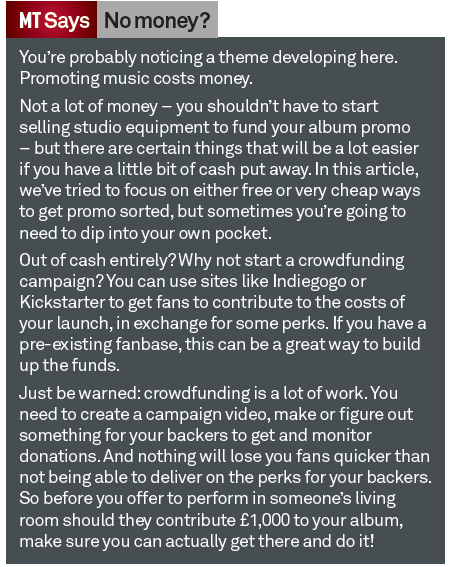Get Your Music Heard – The Ultimate Guide – Part 1
So, you’ve got some tracks together that you’re happy with, but what are the next steps you need to take to bring them before the world? In the first of two major features, Rob Boffard explores tried-and-tested ways of promoting yourself and your music and explains how you can get it in front of the right […]

So, you’ve got some tracks together that you’re happy with, but what are the next steps you need to take to bring them before the world? In the first of two major features, Rob Boffard explores tried-and-tested ways of promoting yourself and your music and explains how you can get it in front of the right people…
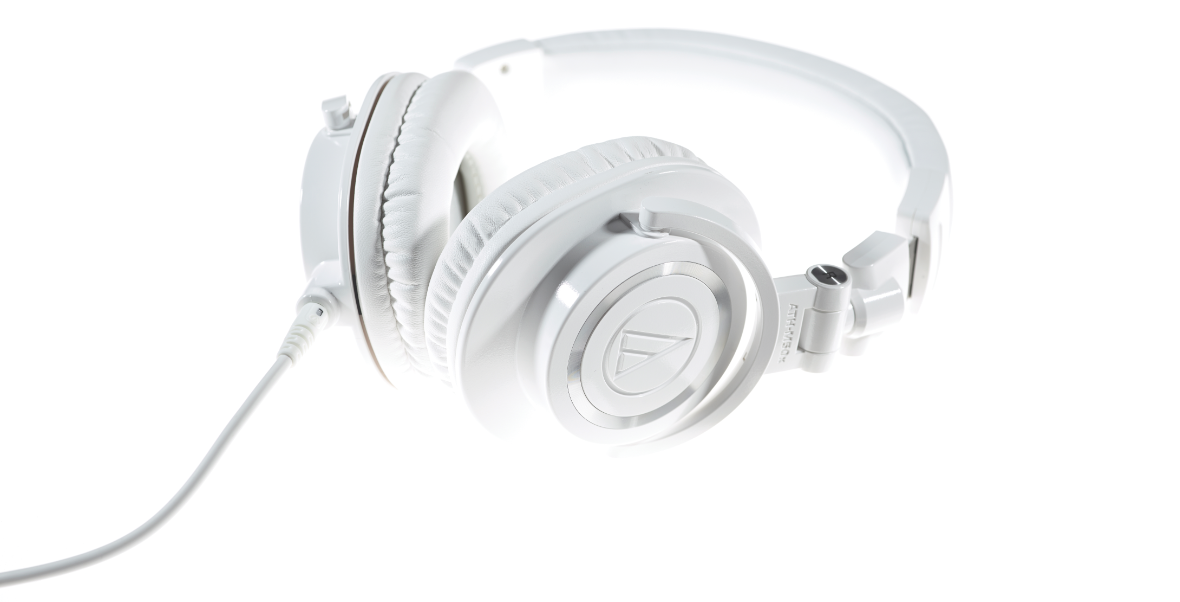
Recording an album isn’t an easy task by any stretch of the imagination, but there’s no question that it’s the fun part of being a musician. You get to do what you love the most: being in a studio, knocking ideas around, creating music, pulling off the perfect mix. You’re working on something that means everything to you – and chances are, you’re having the time of your life doing it.
Most people, however, don’t really like the part that comes after that – and for good reason. Because once you’ve made the album or the EP, actually making sure that people get to hear it is hard. It’s not just about performing gigs – although that is, of course, still a big part of it. It’s all the tiny bits that go with it: your online presence, social networking, meeting people, shaking hands, creating merchandise. Videos, free tracks, podcasts… none of it is sexy, and if we’re going to be honest, it’s not all fun, either.
But that doesn’t stop it from being absolutely essential. You can’t just put your music up on your website and hope that people will notice it. There are more people than ever making music and more people than ever wanting to succeed with it, so you need to stand out, not just with your music but with your promotional tactics too…

Fortunately, while it might seem pretty daunting, there are some pretty straightforward things you can do to make sure that promoting your music is done effectively. None of these are hard-and-fast rules –in music, there are never hard-and-fast rules, whether you’re making it or selling it – but they do have some good principles behind them.
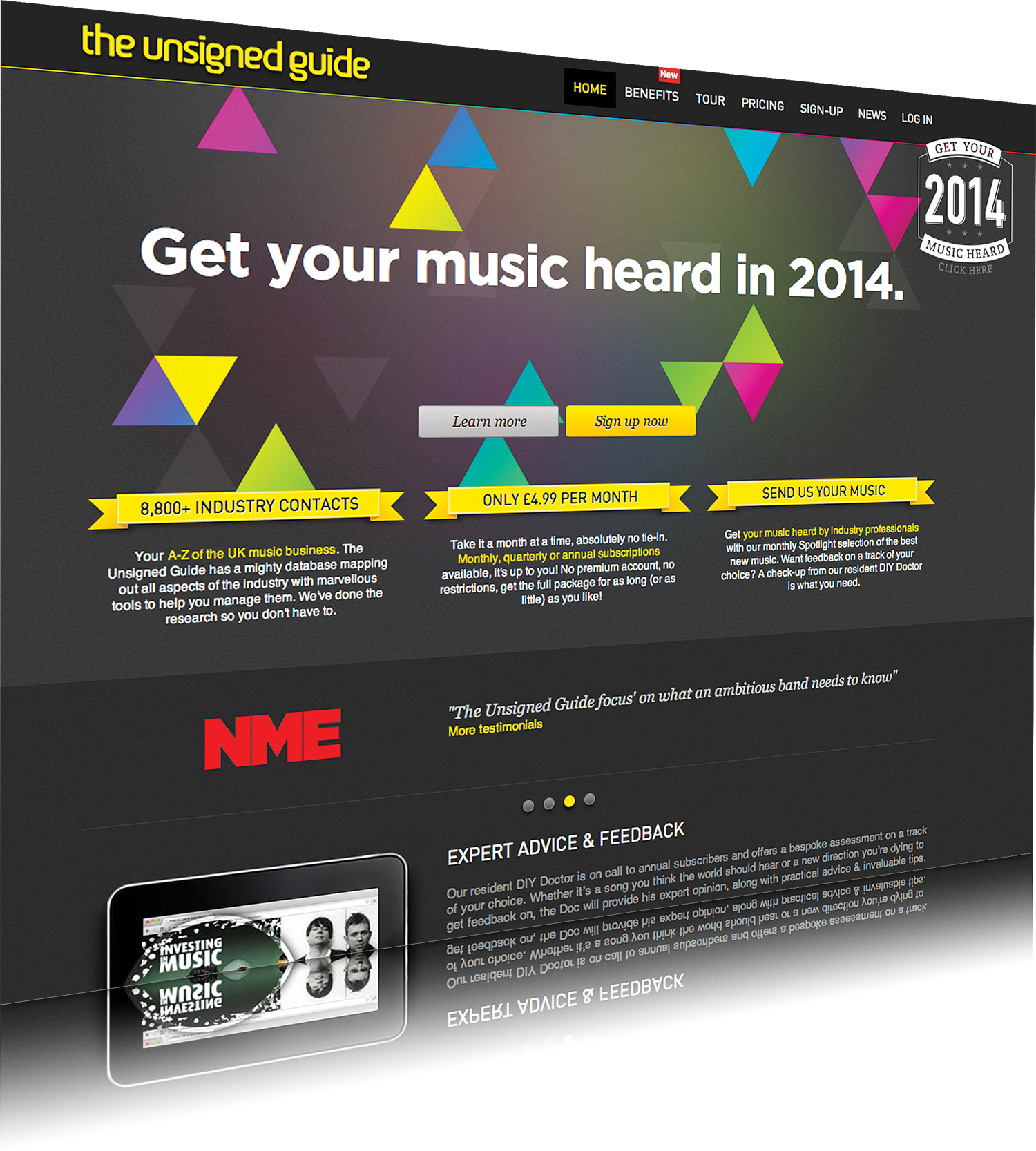
The Unsigned Guide (www.theunsignedguide.com) is a one-stop resource site for up-and-coming bands.
The Essentials
In this, part 1 of the guide, we’re going to go through some of these principles. We’ll talk to key industry figures who act as gatekeepers between you and the listening public: the music PR, the journalist, the radio plugger and the social media expert. We’ll go through all you need to know about promoting your music, from gigging to creating eye-catching posters and merchandise, and designing an electronic press kit.
Be warned: you should be prepared to spend a little bit of money doing this. You can do a lot of it for free, but things will move a lot faster and yield better results if you’re prepared to spend a little to make them as professional as possible. Either way, this is all essential stuff. Dive right in…
Public Relations
If you’re on a label, chances are you’ve got someone helping out with promo already. For the purposes of this guide, we’re going to assume that you’re an independent artist, with music ready to release.
You might reasonably ask why you shouldn’t hire a public relations company to do the job for you. If you have the money – we’re talking a few hundred or a few thousand pounds here – it can be a great way to skip a lot of the headaches. These are people who know the business, who have the contacts/skill to get their clients noticed. They’ll also help you present yourself and your music in the best way possible; you can find out more about this in our interview with James Parrish, of Prescription PR a bit further down.
The downside? The cost. But if you’re prepared to put in a bit of graft – OK, a lot of graft – you could try a bit of DIY PR. PR agencies will try to sell your music and you – not literally, the concept – to their contacts in the media. But in reality those contacts are available to everyone. The cheapest way is to hone in on a few select media that relate to the music you make (DJ Magazine for dance music, for example) and get contact details through their websites. A more expensive option is the Showcase Directory – £75 for 10,000 music industry contacts, including the media and PR companies.
The aim is to find the name of a person who deals with music reviews and email them a few lines and a link or even enclose an electronic press kit (see our guide for more on that). There’s a good argument that sending a well-packaged CD could pay dividends as it has become so unusual these days. Either way, make your bio brief – no one has the time to read anything too long these days. A PR company will include name of artist, label, genre, link to music and a photo – you should do this too. The label might be a sticking point if you are unsigned but it adds a little clout so when you invent your band name, invent a label as well. Everyone, it seems, runs a label, so why not you?

Don’t forget a photo as well. You must know a photographer, as everyone claims to be one! We would advise against simply wearing sunglasses and posing, but try to stand out with an image of some kind (see our guide to creating a press kit).
So you can see by now that the DIY PR option is a tough one. It’s hard work and you will certainly come across as more competent an artist if you are presented to the media by a professional PR company. There is one bit of self DIY you should do, however, and that is to email links, bios and photos to us – we put unsigned tracks in front of the MusicTech experts for feedback and have 150,000 visitors to MusicTech.net every month!
James Parrish Interview – The Music PR Person
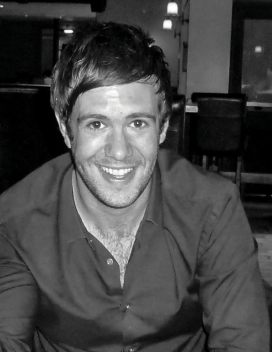
What’s the difference between you and James Parrish? He’ll make you look good…
Type ‘music PR’ into Google and James Parrish’s company Prescription PR is the first result to pop up. The Cambridge-based outfit handles public relations for Paul Weller, Roger Waters and dozens of other household names, as well as smaller outfits like Japandroids, Rufus Wainwright and Big Deal. Parrish founded the agency four years ago, and still runs online and national press. If you’re his client, it’s his job to get you into the public eye.
As you might expect from someone who makes it his business to sell music to often reluctant ears, Parrish comes across as poised and confident. “You come to us and we work out what we’re dealing with: an album, a single, a SoundCloud page… We work with you to make sure you present your project in the best way possible. We’ll help you pick what we think is your strongest material to go to press with. We’d get the imagery and artwork the best it can be; we’d build your profile. You should expect that at the end of the time working together, you have some press coverage to show for it.”
The hardest thing for anyone promoting their music is the sheer difficulty in being heard. There’s so much music available now, via so many different outlets, that it’s a mission just to get above the waterline. “Ten years ago, we didn’t have SoundCloud, broadband internet, access to different bands, and sometimes you might have a wonderful record and you might not hear back from people right away,” says Parrish.
Of course, Parrish and Prescription charge for their services. But you do get what you pay for: Parrish says that what he and other PR companies offer is inside knowledge – knowing who to contact, and how and when to do it.
Whether or not you decide to go with a PR company, Parrish says that having your strongest material available for the media is absolutely key: “No longer can people use the excuse that you just have a demo,” he says. “Home recording is now at a level where you can deliver really quality stuff.”
His closing comments? “Decide where you want your music to be covered, make the best music possible, then go for it.”
Duncan Dick Interview – The Music Journalist

Duncan Dick helps to run one of the biggest music magazines on Earth. Here’s how to get his attention…
Duncan Dick claims to have over 40,000 unread emails in his inbox. We haven’t had the chance to count them ourselves, but it gives you an idea of the kind of stuff a music journalist has to wade through to find new music – and that’s without counting the CDs and press releases that regularly pop through Dick’s letterbox at Mixmag, where he is deputy editor.
Dick studied law at Strathclyde University, but despite his unusual background he has been at Mixmag for over a decade. When it comes to dance music, he helps to ferret out the new talent, and has helped the mag to keep its place as a tastemaker for the genre. While the internet has hit magazines hard, Dick says that no musician should neglect the print press: “It’s definitely got harder for print journalists,” he says. “But the prestige of being featured in a magazine is something that remains, whereas the web can be quite disposable.
Our circulation isn’t what it was ten years ago, but once you have a Mixmag feature, the response from the industry in terms of booking and profile makes a huge difference.” He cites the example of their top-ten DJs list, which he says started a “real conversation” on Facebook and Twitter.
Getting the attention of a journalist – even a freelancer without Dick’s responsibilities – can be tricky. But they remain a key way to get your music in front of listeners, and a mention on a blog or in a magazine can be a real boost – plus, you can splash it all over your social media.
When contacting journalists, it’s best to get the basics right. Unless you have a professionally designed CD package, it’s best to write a polite email with a couple of links and not to be put off if the journo doesn’t get back to you. In addition, Dick says, journalists often have sources, like PRs or DJs, who they trust to deliver them good music: “The most important way that I find new music is through tastemakers. If you can get your music into the hands of DJs, we’ll hear it. If you can get a tune onto a mix and it’s a DJ we respect, we’ll make the effort to find out what the tune is.”
The Show Must Go On
One of the best live shows we’ve ever seen was an in-store performance in London, in a tiny shop, to a crowd of about seven people, at one o’clock on a midweek afternoon. But to the three-man rap crew performing, it could have been Madison Square Garden. They put everything they had into it.
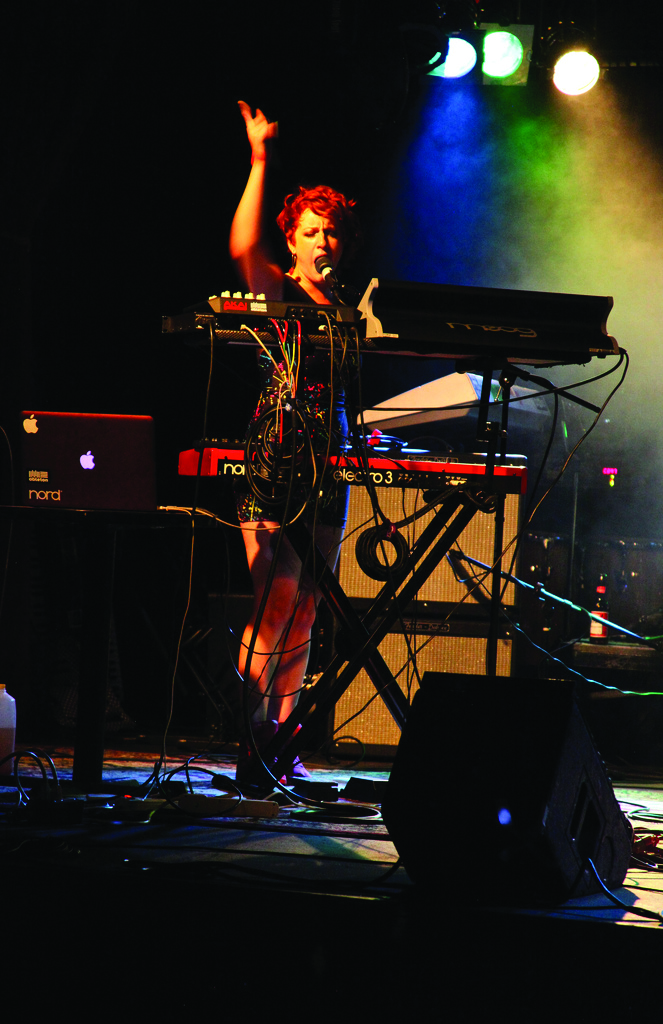
New York singer-songwriter Erin Barra took proactive steps to get her name and talent noticed by the music industry. Check out our interview with her here
The last thing we want to do is try to tell you how to put on a live show. You know your music, what’s best about it, what works and what doesn’t. The only advice we have here is: do give a crap. Be on time, rehearse, get the soundcheck right; giving a crap no matter how small the venue or how seemingly disinterested the crowd.

When it comes to merchandise, there are ways to step up your game. Merchandise serves two roles: getting your name out, and making money. It’s not expensive to order a bunch of T-shirts with your logo on them (don’t have a logo? Get a logo. Find a designer and pay them). You can sell them for a good mark-up, and as long as they look good and you’ve put on a good show, you’ll have customers.
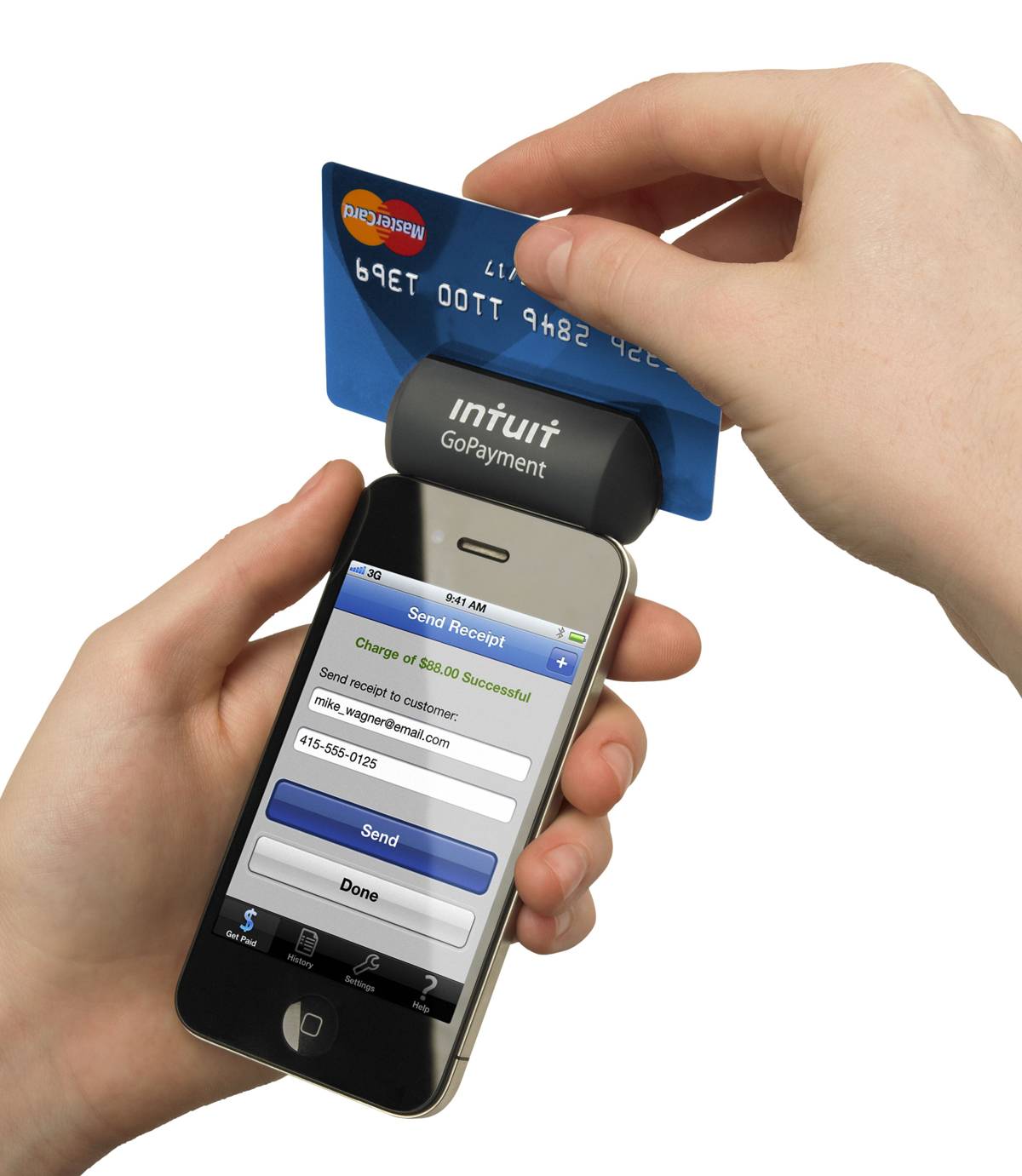
Accept credit card payments anywhere on your iPhone, iPad or Android device: www.intuit-gopayment.com
Try to be inventive with your merchandise as well. T-shirts, hoodies, CDs and the like are all very well, but there’s no limit to the number of things you can slap your logo on. When Aussie rap crew Bliss n Eso came to London in 2012, they were selling beer-holders emblazoned with their logo.
If possible, man the merchandising table yourself – and treat every customer like they’re royalty. Once you’re off the stage, you cease being a musician and start being a salesperson.
We have an additional tip in this regard. Most merchandising tables in a venue will allow only for cash transactions. This is crazy – by the end of the night, many people don’t have £10 or £20 left in their wallet. If you have an iPhone, you can use a plug-in card reader such as Intuit to take mobile payments. If you have this set up, put a big sign up at the merchandising booth advertising that you do, and familiarise yourself with security issues so that you’ll have an answer for anyone who asks about how you’ll keep their details safe.
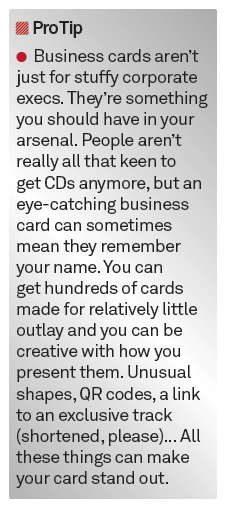
James Passmore Interview – The Radio Plugger
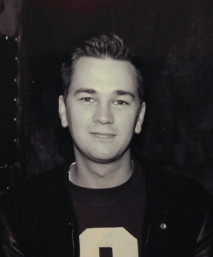
For James Passmore, nothing less than beating Justin Timberlake to the top of charts will suffice…
James Passmore knew he’d pulled off a coup when one of the acts on his roster beat Justin Timberlake to the number one spot on the UK album chart.
Passmore is a radio plugger. As the head of Plugged In PR, it’s his job to get his acts played on as many radio stations as possible, as much as possible. With HAIM, the trio of sisters from the US, he knew he had a challenge on his hands – but with his help, they ended up overtaking JT.
Plugged In has become one of the go-to plugging firms in the UK. Passmore not only managed to get HAIM on his roster, but other acts such as Flume, Bloc Party and The Naked And Famous.
The success of his campaigns, including HAIM’s, came because Passmore knows his radio. In getting airplay on any station, knowledge is key: “It’s extremely important to know the shows you’re plugging so you can ensure that you only send them music that is appropriate to their output,” says Passmore. “By doing this you can gain their trust, so that when you flag a brand-new band to them, they take notice.”
When you’re pitching songs to radio, he explains, it’s also important to manage expectations. There are only so many slots available on any playlist, after all – and it can be mighty tough to get a song onto some of the bigger shows.
“I start my campaigns by trying to pick up support for the single from the specialist shows that I think are best placed to champion the act and start building a story and profile for them at national radio,” Passmore says.
Like any service, radio-plugging costs money. While Passmore says that artists need to employ a plugger if they want to “step things up and build towards regular specialist play and playlists,” he also says that artists would be crazy not to take advantage of the free services. Things such as BBC Introducing and Amazing Radio are great for independent acts to get some airplay: “If you’ve already had some radio support then you will be a much more attractive proposition to potential pluggers, record labels and publishers,” he notes.
Easy Access
A key element to promoting music is making sure that your tunes are available on the outlets your listeners use – not just the ones you use. For most people, that means services like iTunes or Spotify.
To get music onto these services you’ll need to apply, which can be done online. Although there are some hoops you’ll need to jump through, particularly with iTunes (which demands things in a certain format, and that music has ISRCs, or International Standard Recording Codes), it’s still very possible to get onto the services. That being said, it may be worth looking into what’s known as an aggregator: a service designed to get your music onto as many services as possible. Companies like TuneCore or CDBaby will take care of all the admin for you and are usually inexpensive. Whichever way you choose, the key is to make your music available and inexpensive.
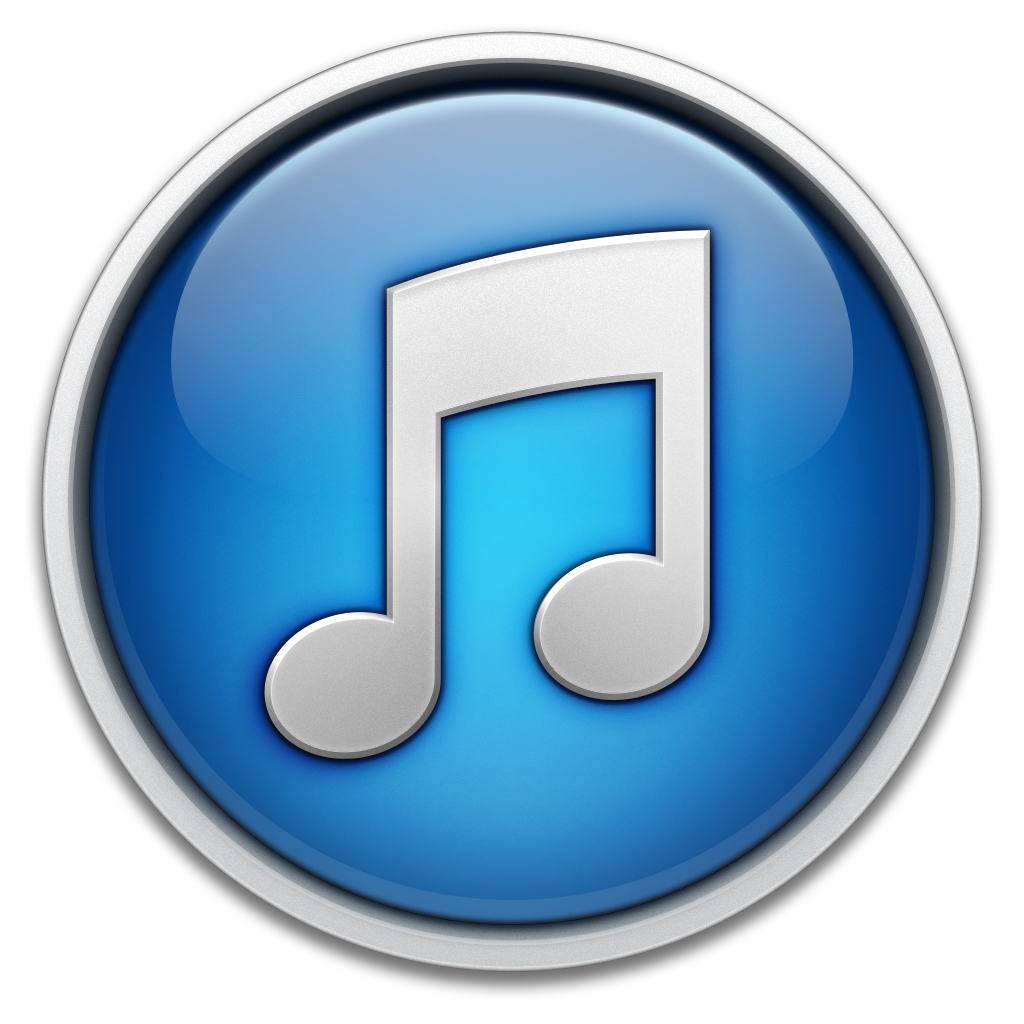
Explore the numerous online outlets to make your music available to the listening public. Note that many services will require you to submit tracks in certain formats, so check first to avoid wasting time.
Of course, it doesn’t stop there. Once your music is ready for release – if, for example, you’ve got a single burning a hole in your hard drive – then check out some podcasts and online radio shows. Getting tunes onto regular radio can often be quite tough (just ask our radio plugger, James Passmore, who we speak to elsewhere in this tutorial) but podcasts are usually an easier bet.
Crucially, they don’t need massive audiences to be effective. Good ones tend to have very dedicated audiences, and if they like your tune, you’ll have some solid fans you can depend on. Make a list of podcasts you like and politely hit up every single of them. Offer an MP3 or two, a brief explanation of what you do and why you think the DJ needs to hear your stuff.
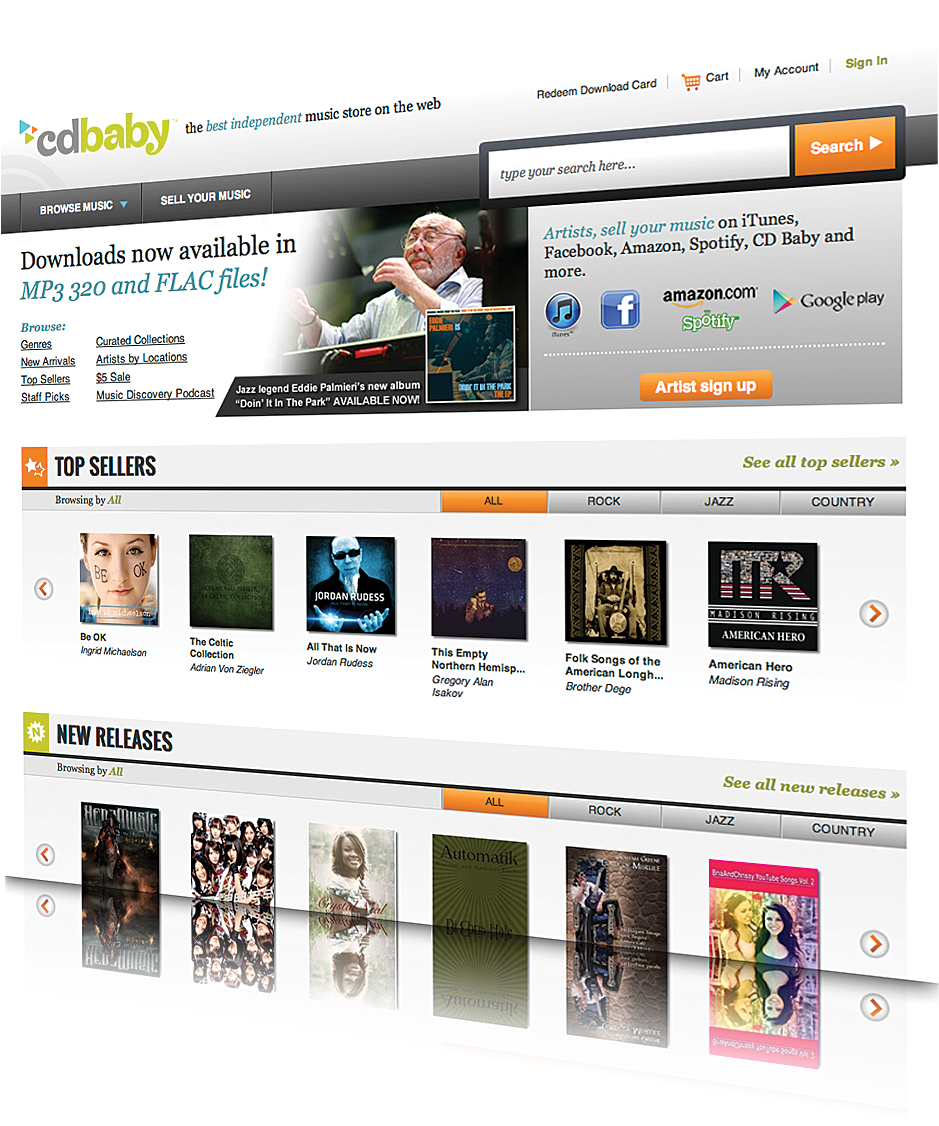
Check out websites such as CDBaby (www.cdbaby.com) and podcast services for further promotional opportunities.
When you do get airplay, be sure to thank the people who got you it. We simply can’t stress this enough. A Facebook post or a Tweet linking to the show will do the trick.
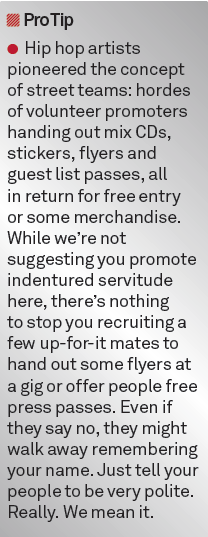
Next time, we go online as we reveal how to create the ultimate web presence for your music, from setting up Bandcamp pages to building a good, solid website.
Click here for our guide to making an Electronic Press Kit
